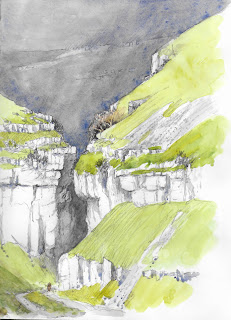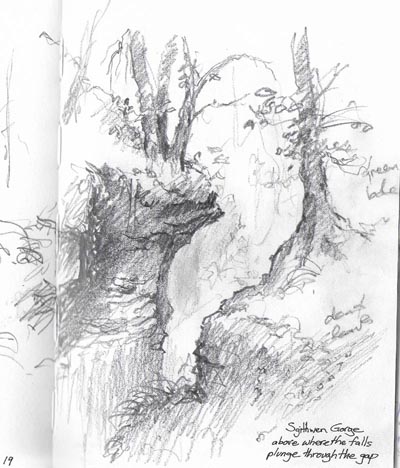I’ve managed a pretty wild and wonderful autumn this year, though it has left me breathlessly out of kilter on the blog-writing front, I’m afraid. How I wish there was more time for writing, which I love, but sadly in this robotic world there are so many threats to writers and their writing-time. For eample, in New Zealand their libraries archive has intended to put thousands of books’ contents onto the internet, but it seems that after world-wide protests they’ve just realised there’s a thing called copyright involved!
We’ve been blessed with a gorgeous little grand-daughter by the name of Beatrix, and look forward to meeting her on the run-up to Christmas. Her Dad’s going to be performing in pantomime at Margate, so it’s going to be a bit riotous, Covid-permitting, of course.
This is a watercolour sketch of Gordale Scar in Yorkshire, carried out on a beautiful calm, sunny afternoon in October while sitting in a most uncomfortable position on extremely steep ground high above the valley. The light falling on the limestone really made the rock stand out, particularly against the shadowy parts. It is deliberately overworked so that I have all the details to produce a large studio watercolour, and my awkward position didn’t help. This is actually only the right-hand half of the composition and the cartridge paper has been left unpainted where the sunlight is hitting the limestone.
There is too much green for my liking, but grass growing on limestone has that intense colour, and I wanted to record a faithful rendering. In a studio painting I will doubtless take more liberties, lose a lot of hard edges and make other adjustments, but my point here really is to show how working out of doors like this is to me not just a means of acquiring the information for a finished painting, but also of observing how the traditional approach will appear, so that I can see where I need to be more creative in the later attempt.
The Covid-induced layoff has been a real nuisance, but we are now organising courses for 2022 as you will find on my website . There is one in Mid-Wales in April, and another in Cornwall in September, both popular locations with lots of interesting subjects. I may well be adding more in due course. Also on the website you will find information on my books, the last one published being the Landscapes Through the Seasons in Watercolour, and they are all available via the website
I hope you are managing to get out and about with your sketching and painting gear – even in December we can get some lovely days, and the low light can create some fabulous cast shadows.





